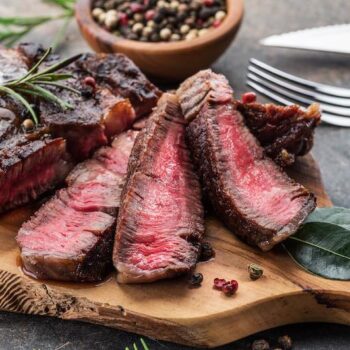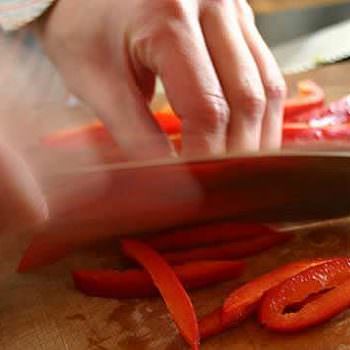The Recipe for Cooking Steak Like a Pro
Steak can be part of a healthy diet and is one of those foods that should be in the “occasional” category. However, when you decide to include a steak in your diet, you want it to taste good!
The great mystery as to how restaurants can achieve a far superior steak than you’d create at home is revealed through a few simple steps. These steps include quality ingredients, seasoning, temperature control, and resting.
Choosing the steak cut
The principles for cooking the perfect steak are essentially the same whether the chosen cut is fillet, ribeye, sirloin, bavette, or rump.
Each cut suits a different final temperature depending on your preference. This guide will focus on sirloin and can be applied to any of the listed cuts.
Purchase the highest quality meat within your budget, as this is a key factor in the quality of your final product.
Choosing the pan
Steaks should be cooked in a large heavy-duty frying pan as they will retain the heat best during cooking.
Griddle pans are also well suited with the ability to hold high temperatures and achieve the classic steak grill marks even when cooking indoors.
If cooking outdoors, cook steak on the BBQ over high heat to develop a deep crust with smoky background flavors.
Seasoning the steak
Season the meat liberally with salt. If using black pepper, this should be added once the meat is removed from the pan as the seasoning can burn easily, adding a bitter note to the steak.
A classic addition to the cooking pan is to finish the steak with a clove of crushed garlic, a sprig of thyme and rosemary, and a knob of butter.
Basting the foaming butter over the meat enriches the steak and imparts the flavors of garlic, thyme, and rosemary.
Marinades offer a boost of flavors and an opportunity to tenderize tougher cuts such as bavette or onglet. The choice of marinades is endless, with a few favorites being teriyaki, chimichurri, balsamic, BBQ, or red wine.
Choosing a cooking oil
Use a non-flavored high smoke point oil such as peanut, grapeseed, or sunflower oil.
Apply the oil to the meat rather than into the pan to prevent the steak from sticking and encourage a crust to develop. Once the steak is seared, add butter to the pan for increased richness.
The temperature of the steak
Begin by bringing the steak to room temperature, ensuring even cooking throughout.
You can test the cooking of the meat by touch, checking the firmness of the steak with your finger, which provides a guide to how well done the meat is.
The most accurate way to check the steak’s cooking is using a meat thermometer.
- Blue 115°F – 120°F
- Rare 125°F – 130°F
- Medium Rare 130°F – 140°F
- Medium 140°F – 150°F
- Medium Well 150°F – 155°F
- Well Done 160°F +
Resting the steak
Resting is as important as cooking; the steak should rest for the same time as cooking.
The steak is still cooking through residual heat, and allowing the process to complete will result in a moist steak. When you cut into a steak that has just finished cooking, you will notice that a lot of juices run from the meat. Resting allows these juices to be reabsorbed.

Perfect Sirloin Steak Recipe
Equipment
- Large Saute Pan
- Kitchen Towel
- Tongs / Spatula
Ingredients
- 7 ounces sirloin steak
- 2 tbsp peanut oil
- sea salt to taste
- 1 tbsp butter
- 1 clove garlic crushed
- 1 sprig of thyme (dried leaves work too)
- 1 sprig of rosemary (dried leaves work too)
- black pepper to taste
Instructions
- Remove the steak from the refrigerator and allow the meat to come to room temperature, approximately 20 minutes. Pat the meat dry with a kitchen towel which will help to develop a crust when cooking.
- Pour the sunflower oil over the steak and season well with salt, then rub the oil into the meat using your hands.
- Place a large sauté pan on a high heat and allow it to come up to temperature. Then add the steak to the pan and sear for 2 minutes without moving the meat.
After 2 minutes flip the steak and cook for 2 minutes more on the opposite side. Rare – 1 minute each side, Medium Rare – 1 ½ minutes each side, Medium – 2 minutes each side, Well Done- 4 minutes each side. - A dark crust should have developed on either side of the steak, check the cooking with your finger (firm with a bit of a spring) or a meat thermometer.
- Remove the pan from the heat and add the butter, garlic, thyme and rosemary. Baste the butter over the steak then transfer the steak to a plate and pour the contents of the pan over the meat.
- Cover the steak with a kitchen towel and allow to rest for 5 minutes.
- Once rested, serve the perfectly cooked medium sirloin and season with freshly cracked black pepper.
Notes
Nutrition
This recipe comes courtesy of BigHomeSavings.com, a site that reviews home appliances such as grills.


 Fresh and Healthy Caprese Salad Recipe
Fresh and Healthy Caprese Salad Recipe Breakfast Burrito Bowl Recipe: Meal Prep Style
Breakfast Burrito Bowl Recipe: Meal Prep Style 5 Plant Based Meal Ideas For Macro Dieting
5 Plant Based Meal Ideas For Macro Dieting 10+ Delicious and Clever Ways to Eat More Vegetables
10+ Delicious and Clever Ways to Eat More Vegetables